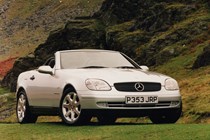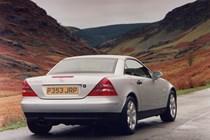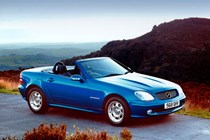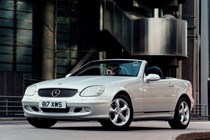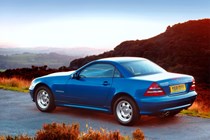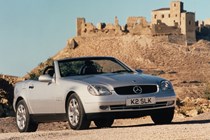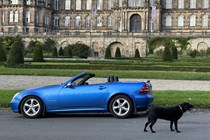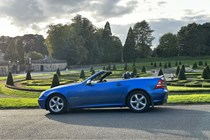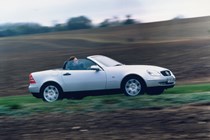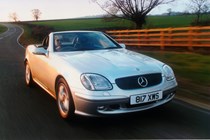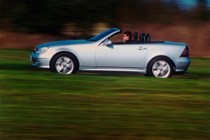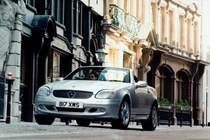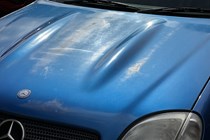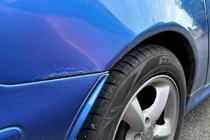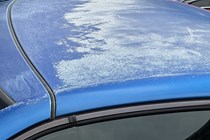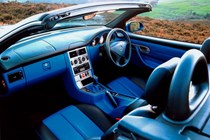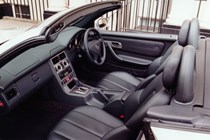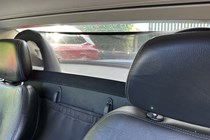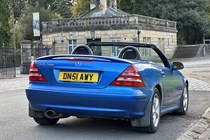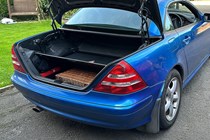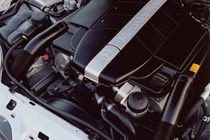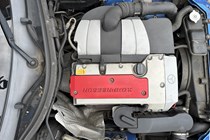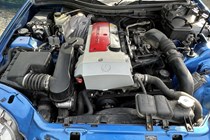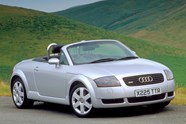
Mercedes-Benz SLK Roadster review
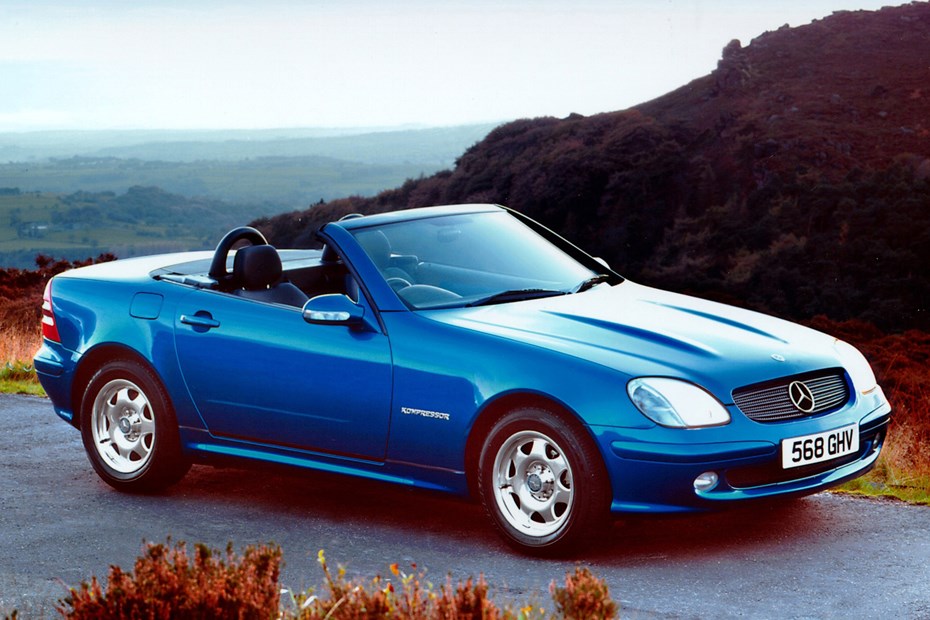
At a glance
| Price new | £25,670 - £45,537 |
|---|---|
| Used prices | £611 - £2,946 |
| Road tax cost | £345 - £415 |
| Insurance group | 32 - 37 |
Get an insurance quote with

|
|
| Fuel economy | Not tested to latest standards |
| Range | 317 - 383 miles |
| View full specs for a specific version | |
Available fuel types
Petrol
Pros & cons
- Refined convertible experience
- Easy to maintain, reasonable fuel economy
- Surprisingly practical
- Solid build undermined by rust and paint issues
- Neglected cars expensive to diagnose
- Not particularly sporty for a sports car
Mercedes-Benz SLK Roadster (96-04) rivals
Overview
Despite its historical significance, the original Mercedes SLK (R170 to Mercedes fans) is a downright cheap, practical used car. It’s a modern classic which remains readily available in Britain, is relatively cheap to run, and can be maintained at home with a simple set of tools. Based on the family-sized Mercedes C-Class, the SLK is comfortable and spacious as well as refined.
Why is the SLK significant? It marks the beginning of new era of Mercedes-Benz; softer lines, more fun, and wider audience appeal. Throughout the 20th century Mercedes pushed car technology and safety to new levels, yet it was almost always concealed behind a uniform, rather severe face. The SLK, alongside the Smart and A-Class, introduced the idea that a Mercedes could be both fun and affordable.
Offered from 1996 to 2004, the first generation Mercedes SLK features petrol engines in four-cylinder or V6 configurations and a choice of manual or automatic transmission. All are rear-wheel drive, though the suspension, steering and wheels are chosen for a safe, relaxed nature even in the highest-performance SLK 32 AMG. Tuners such as Brabus, did offer more extreme conversions but on a bespoke basis. Many four-cylinder SLKs are supercharged.
The SLK introduced a trend for insurance (and weather) friendly hardtop convertibles that influenced Peugeot, Volvo, Ford, BMW and even Mazda. It was not short of competition – roadster buyers could also go for an Audi TT, Porsche Boxster, BMW Z3, MG F or TF, Honda S2000, Mazda MX-5 or Nissan 350Z.
A similar decision faces used buyers, but a used SLK is now the budget option.
Mercedes SLK (R170) known faults and common problems
There are many good reasons to choose a used Mercedes SLK as a modern classic, a first project car, or even just a cheap daily driver. They are one of the cheapest cars you can find with MOT and in running order, and the four-cylinder engines are relatively economical compared with rivals too – particularly for long motorway drives.
With the roof up the boot puts many small family cars to shame. They are easy to maintain (DIY or local garage, no need for specialists), with excellent spares availability, and unlike later, more tech-laden Mercedes models the original SLK has few gadgets, and fewer expensive, bespoke modules such as digital instruments or complex control panels.
Many 2001-on models are even ULEZ-compliant. It’s worth checking the registration of a potential purchase against the TfL website or your local clean air zone before dismissing it due to age. SLKs can be found on most classified and car sales websites; try to find cars from the middle of England and Wales, avoiding coastal and salt-road northern winter cars.
1996 to 2004 SLK buying guide
Common issues, and what to look for if you’re looking at getting one
1. R170 SLK rust issues
Early SLKs have better paint, but are prone to rust on panel edges and near clips and trim. Facelift models have full plastic covers on the sills and seem to age less well, hiding the rust before it can be attended to. The most obvious location you’ll spot at a glance is the front wing above the bumper, but that is just a reminder to get underneath and be thorough.
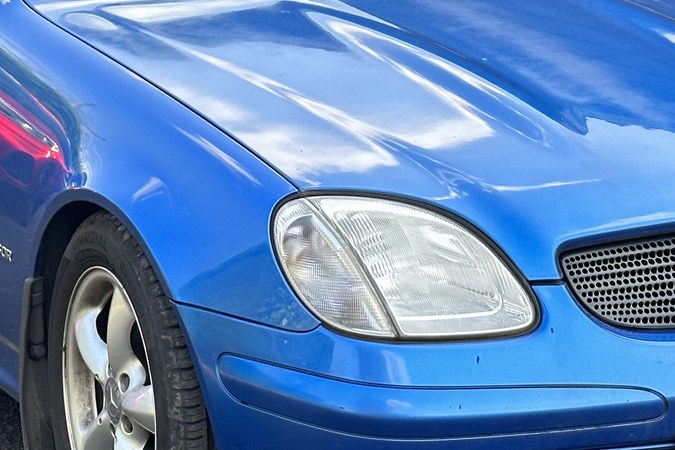
Check the MOT history online for advisories as a guide to a specific car you’re viewing, but you want to pay attention to rust around the rear arches, along the sills, and creeping out at the join of front wing to sill. These areas show rust on the main body.
Underneath, check the cups (perches) for the front suspension springs, the rear subframe mounts, and overall condition. Don’t worry about the thin, bolted-on reinforcement bars if the rest of the car is good – they’re cheap and should be easy to replace.
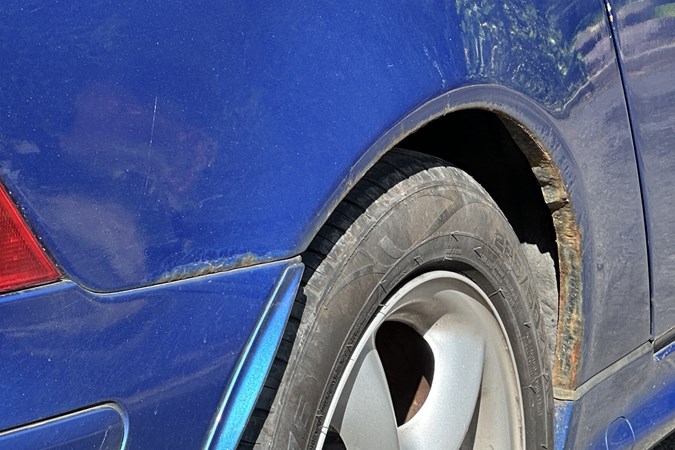
Cosmetic rust often ruins the boot lid, starting around the handle, and the roof panel and the leading edge of the bonnet are also vulnerable. These parts bolt on, so for a cheap mechanically sound car it’s up to you if you can live with it. We would not recommend spending lots on cosmetic restoration as SLK values are so low.
2. Damp and leaks
The SLK’s vario roof seals well, but drain channels front and rear are often neglected. There are electronic modules in the passenger footwell and in the boot which can be affected by long-term exposure to water, so if a car is heavily misted up or has soggy carpets make absolutely sure everything works including the central locking and tail lights. The ‘PSE module’ in the boot is the most common failure point here.
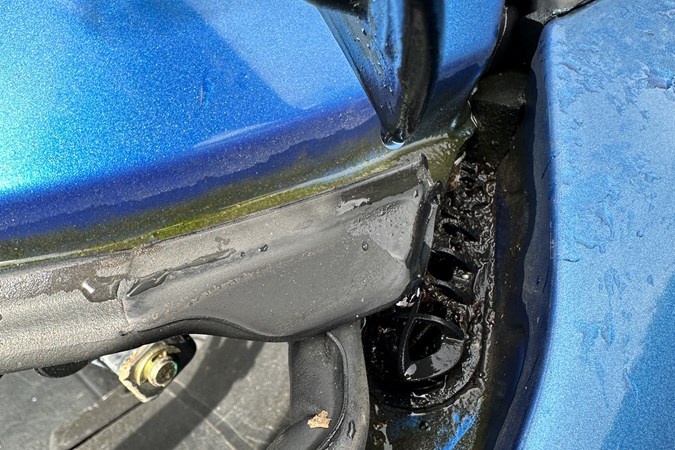
The front drain holes are are harder to see, but the rear and roof drains are clearly visible when the boot is open.
3. SLK R170 Vario roof problems
Despite the drama and complexity of the SLK’s folding hardtop, it’s usually one of the last things to fail. The operation is controlled by microswitches including sensors to make sure the luggage cover is in place, and hydraulics. The former can fail with age and lack of use, the latter usually fails because the seals are leaking. Look at the roof fluid level in the right hand side boot compartment.
Leaking roof solenoids can be indicated by tell-tale dark stains on the front of the headlining. Fixing the hydraulic system is a fiddly, but DIY-able process as long as no-one has messed with the alignment and engineering of the mechanism.
4. Four-cylinder engines (M111) – basic checks
The Mercedes SLK’s four-cylinder M111 engine, in 2.0-litre and 2.3-litre form, is easy to service and very reliable, but that means it’s often neglected. Misfires and an unusual rattle at idle can be caused by failure of an inexpensive, easily-replaced magnet on the front of the engine. This can show on a code reader as a cam sensor issue but you can check it when buying just by unclipping the plastic cover – if there’s a visible oil leak, chances are the wiring also has oil in it; Mercedes modified later cars with a short cable to protect the ECU.
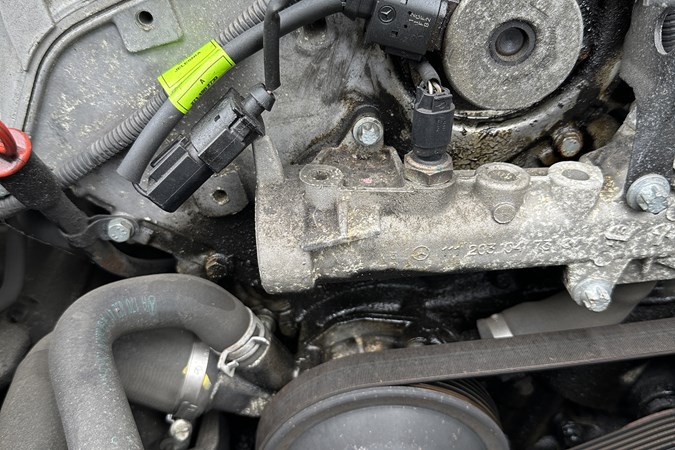
Oil changes are done from above including the filter, using a vacuum pump. There’s no excuse for neglect here. In extreme cases you may find timing chain wear and rattles, but the engine is not particularly refined even in perfect health. Staining around the oil filler and plastic/rubber breather hoses can indicate engine wear, but it’s more likely to be blocked PCV nozzles.
This excess oil can contaminate the MAF sensor, an expensive part if genuine, so look for service notes to suggest this maintenance has been done on cars over 75,000 miles.
5. Six-cylinder engines – basic checks
The V6 is a tighter fit under the bonnet so harder to maintain, and more complicated overall. It uses twin spark technology, and higher-mileage neglected engines will have trouble with emissions and poor running as the low price of the car means few owners want to pay for 12 high-quality spark plugs.
Look at oil and coolant condition and listen for timing chain rattle. Overall the M112 V6 engine is robust, but less tolerant of neglect. Look for frequent oil changes, plugs in the last 20,000 miles, and if the car runs badly walk away.
6. Supercharger and ancillaries
Most four cylinder SLKs are supercharged – known as 200K or 230K, they are simple and reliable, and power is quite modest as they are tuned for efficiency. Early models have an electromagnetic clutch to engage boost – which you can test from idle by revving to 2,500rpm and watching, or listening, for it engaging. Later models are constantly driven and use an electrically controlled valve to regulate boost.
If the supercharger does not engage it’s likely that the cam magnet or sensor have failed but it could also be an electrical fault elsewhere. On higher mileage cars look for evidence that the supercharger oil has been changed.
The only supercharged V6 model is the SLK 32 AMG, and we would recommend paying for an independent inspection if you’re not confident that you can assess it yourself.
7. Automatic gearbox
The automatic gearbox is the 722.6 five-speed shared with almost every Mercedes made during this era, and also some Chryslers. It is a robust and simple unit by modern standards, but it has two weaknesses. The first is that it was launched as sealed for life – later revised to fluid changes at 44,000 mile intervals. Early examples where this service was neglected naturally fail prematurely.
The second is the ‘pin bushing’ leak. Gearbox fluid can leak past the original connector and into the wiring look. In extreme cases this can cause serious problems, though for most cars it’s a case of cleaning the connector and replacing the inexpensive plastic insert. A good gearbox specialist will change this part while performing a fluid and filter change. Neglect can cause issues with the conductor plate resulting in slurred or missed shifts, or ‘limp home mode’ remaining in second gear.
There is a dipstick tube, but no dipstick. The cap is sealed with a black tamper-proof insert – once the car has been worked on a red clip is used. If there’s no red clip, question any claims that the gearbox has been serviced; if you are serious about buying an SLK you can buy a dipstick to check ATF condition but be prepared to give the seller a new clip each time.
8. Manual gearbox and rear axle
You will find the occasional SLK with a manual gearbox, and the six-speed unit is robust but not particularly sporty in feel. On cars without air conditioning the access to the engine and gearbox is remarkably easy for a modern car, and if insurance is not a barrier then a basic manual SLK is a great way to learn more advanced car maintenance.
On manual and automatic SLKs vibration and clonks when engaging drive can be caused by worn propshaft couplings. which are relatively easy to replace. Rear CV joints and bearings are robust, but on rusty cars the ABS rings can break, which also disables the traction control.
9. Suspension and steering
Unlike most sporty cars the SLK uses a steering box like that found in Mercedes saloons of the ’70s and ’80s. This is a smooth, relaxing setup, but it has more wear points than a rack and pinion including the service item of a steering damper that absorbs small movements from the road, and keeps the steering wheel comfortable. Any odd variation in feel through curves may be this easily-replaced part.
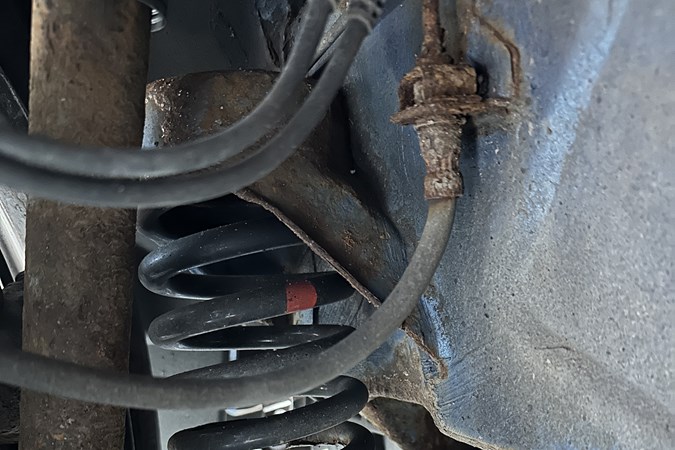
SLK suspension is strong and complex. It’s also relatively easy to maintain if you buy the right tools, such as a disc-style coil spring compressor. When it does wear there are a lot of bushes and parts to diagnose – most SLKs make it well into six-figure mileages with minimal attention, front balljoints and tie-rods being the weakest links. The staggered alloy wheels (wider at the rear) are a necessary part of the SLK’s relaxed, safe handling so be wary of cars with aftermarket alloys.
10. Electrical systems
Some aspects of the SLK’s electrics are covered by the damp and automatic gearbox sections, but overall the R170 is a farily simple car compared with modern setups. Most electrical components are in the large box near the battery under the bonnet – this includes the 38-pin diagnostic connector in early cars. You’ll find an OBD-II connector near the bonnet release. Lights, alarm and central locking issues suggest problems with the PSE module in the boot next to the spare wheel, almost always a result of water ingress.
Problems with starting or supercharger boost can be traced to the K40 relay, which can suffer dry joints and bad contacts; not all problems relate to that component, but it’s worth opening that box and looking for bodges and evidence of past work. Behind the carpet in the passenger footwell is a power distribution point and on some models there are additional ECUs, leaking front drain points can cause problems here including flat batteries, faulty lights and general hard-to-trace issues.
On early models the wiring loom can degrade with heat and time. Diagnosis is time-consuming and expensive at a dealer, so if you are looking for a DIY project a clean, well maintained car being sold with such issues might be worth investigating and fixing with a second hand loom.
What’s the original SLK (R170) like to drive?
Over the next few pages, we’ll review each aspect of the Mercedes SLK (R170), taking into account its practicality, comfort, fuel economy and performance. If you’re short on time, you can also skip to our verdict page to see if we recommend the Mercedes SLK as a good used car.



